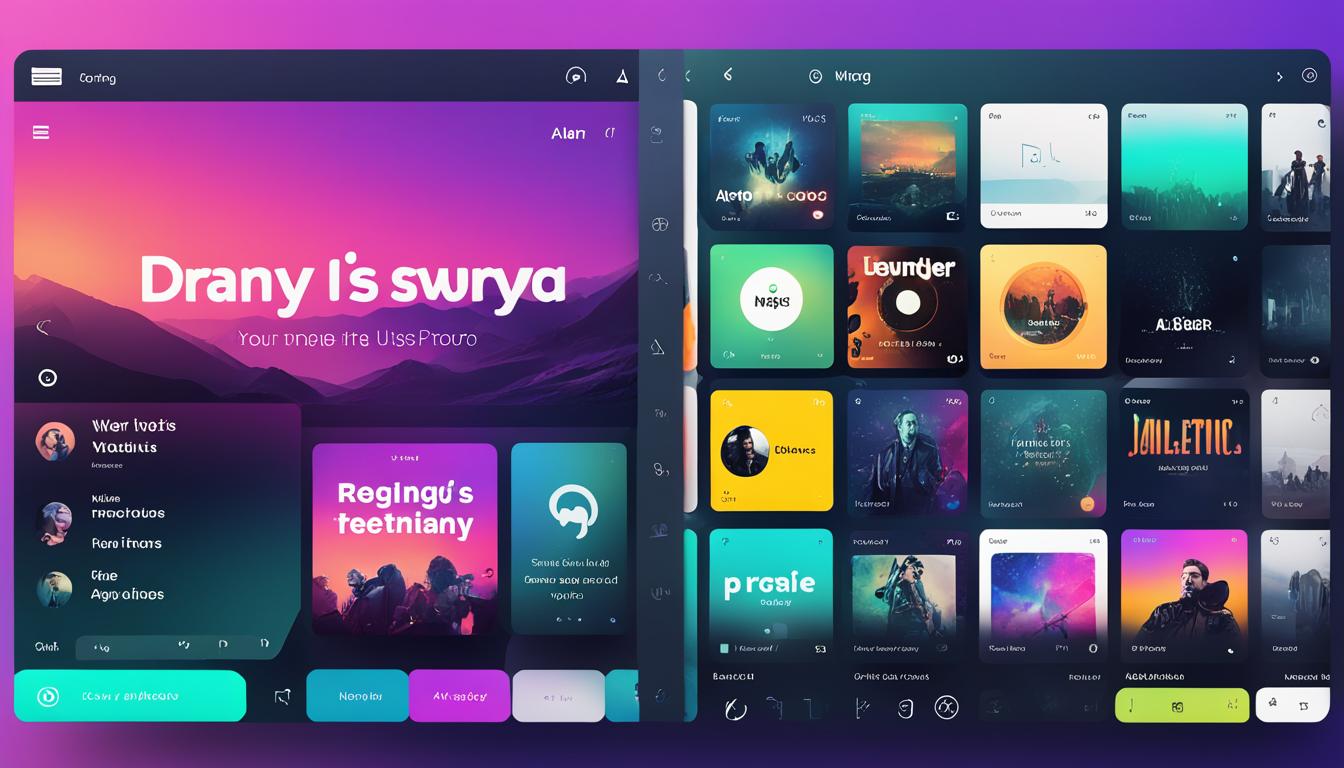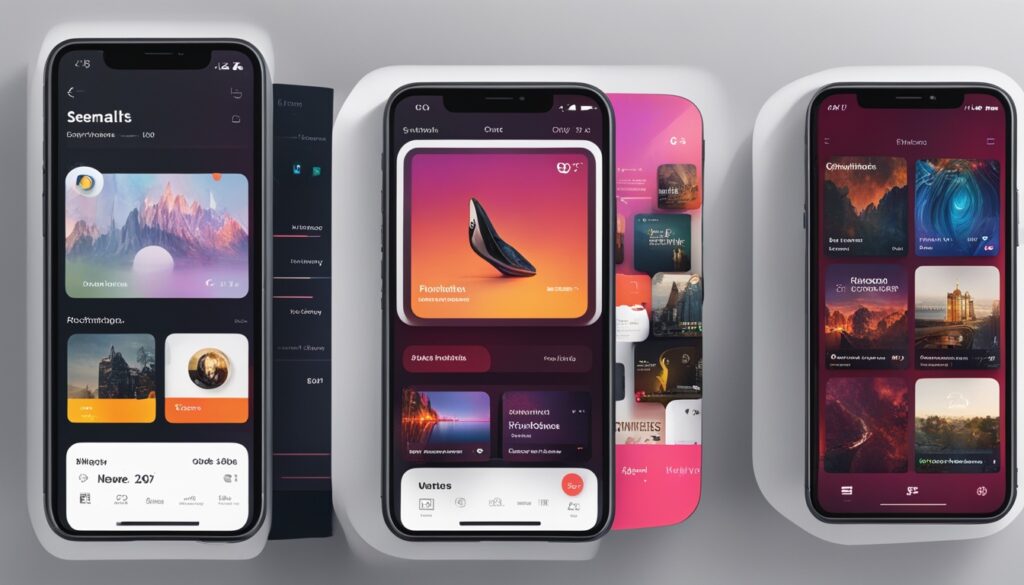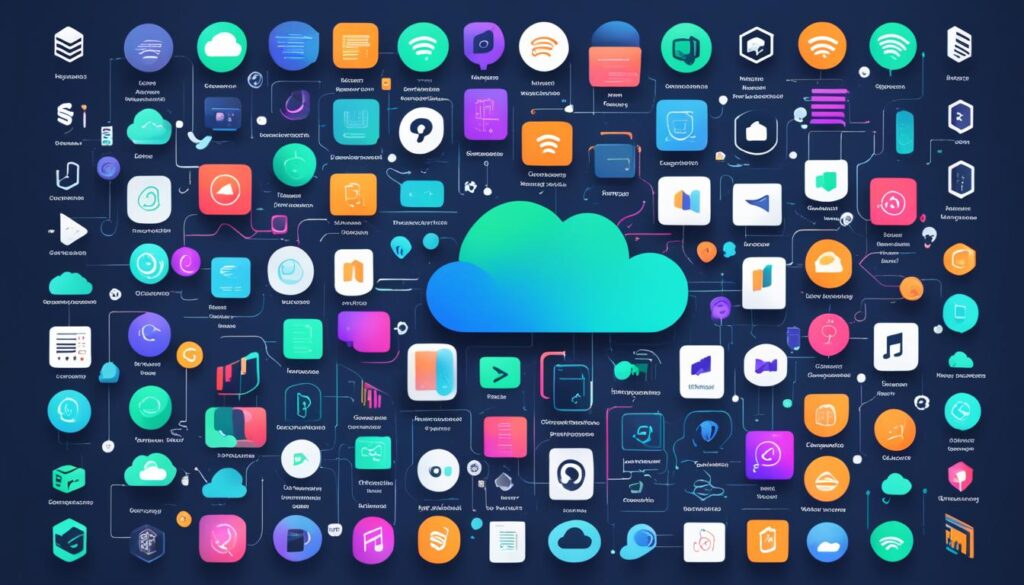The rise of music streaming platforms like Spotify has changed how we enjoy music. Now, making a Spotify-like app is a big goal for entrepreneurs and businesses. This guide will show you how to make your own successful music streaming app.
Table of Contents
Key Takeaways
- Understand the essential features of a music streaming app like Spotify
- Explore the ideal technology stack for developing a music streaming platform
- Discover strategies for monetizing your music streaming app
- Learn about the legal considerations and licensing requirements
- Develop a robust search and recommendation engine for your music app
- Optimize your app’s performance and scalability for a seamless user experience
- Implement effective marketing and growth strategies to attract and retain users
Introduction to Music Streaming Apps
The music streaming industry has grown a lot in recent years. This growth is thanks to platforms like Spotify, Apple Music, and Amazon Music. These platforms offer easy access to music and help users find new artists and playlists they like.
A recent report says the global music streaming market will hit $28.8 billion by 2027. It will grow at a 13.5% annual rate from 2020 to 2027. Music streaming apps have changed how we listen to music. They give us a smooth and personalized way to enjoy music.
Benefits of Developing Your Own Music Streaming App
Creating your own music streaming app has many benefits. You can make a platform that meets the specific needs of your audience. This way, you can offer a unique music experience that stands out.
- Tap into the booming music streaming market and capture a share of the growing revenue opportunities.
- Offer a tailored user experience that sets your app apart from the competition, enhancing user engagement and loyalty.
- Leverage data-driven insights to deliver personalized recommendations and create a more engaging platform for your users.
- Potentially generate significant revenue through subscription models, in-app purchases, and targeted advertising.
Spotify’s success, with over 365 million active users, shows the huge potential of the music streaming industry. By making your own app, you can join this booming market. You can give users a unique and exciting way to enjoy music.
Developing a Music Streaming App Like Spotify
Creating a music streaming app like Spotify needs a strategic plan. You must think about the app’s features and the technology to use. The process includes several important steps.
First, you need to decide on the main features of your app. These include user sign-up, managing profiles, streaming music, making playlists, searching for songs, and sending notifications. You might also add special features like showing lyrics, a music event calendar, and video streaming.
- Conceptualize the app and its key features
- Choose the right business model (e.g., subscription, freemium, advertising)
- Obtain necessary music licensing and content rights
- Select the appropriate technology stack for front-end and back-end development
- Develop the app with a focus on user experience and scalability
To build a Spotify-like app, you need to know the tech behind it. This means picking the right tools for the front-end and back-end. You also need to make sure the app can play audio and video well. A good search and recommendation engine will make the app better for users.
| Front-end Technologies | Back-end Technologies |
|---|---|
| React.js, Angular, Vue.js | Node.js, Django, Ruby on Rails |
| HTML, CSS, JavaScript | MongoDB, PostgreSQL, MySQL |
| Mobile frameworks (iOS, Android) | AWS, Google Cloud, Microsoft Azure |
By following these steps and using the right tech, you can make a music streaming app that stands out. It can compete with Spotify and attract your target audience.
“Building a successful music streaming app requires a deep understanding of the industry, user behavior, and the latest technological advancements.” – John Doe, CEO of Music Streaming Solutions
Essential Features for a Music Streaming App
Creating a music streaming app like Spotify means you need lots of features. These should meet the different needs of your users. Features like managing a huge music library and giving users personalized experiences are key. They make your app stand out in the crowded music streaming market.
Music Library and Streaming Capabilities
A music streaming app’s core is its ability to offer a huge music library. It should let users stream a wide variety of genres, albums, and playlists. This caters to everyone’s musical tastes.
Adding features like high-quality audio playback, offline listening, and custom playlists makes the experience better. These can make users enjoy their music more.
User Accounts and Personalization
Keeping users happy with your app means making it personal. Let users create their own profiles and save their favorite artists and songs. Show them music they might like based on what they already listen to.
Linking with social media lets users share their music tastes. They can also find new artists through friends.
| Music Streaming App Features | Description |
|---|---|
| Vast Music Library | Provide access to a comprehensive collection of music genres, albums, and playlists. |
| High-Quality Audio Playback | Ensure seamless, high-quality audio streaming for an enhanced user experience. |
| Offline Listening | Allow users to download and listen to their favorite music even when they don’t have an internet connection. |
| Personalized Recommendations | Utilize user data and listening habits to provide personalized music recommendations. |
| Social Media Integration | Enable users to connect their social media accounts to share their music preferences and discover new artists. |
With these key features, you can make a music streaming app that’s both full-featured and personal. It meets the needs of your audience and makes your app unique in the market.
Choosing the Right Technology Stack
Creating a successful music streaming app needs a strong technology stack. This stack must support the app’s functionality, performance, and growth. In the world of music app tech stack, both front-end and back-end technologies are key. They ensure a smooth user experience.
Front-end Technologies for Music Streaming Apps
The front-end is what users see and interact with. Popular front-end technologies for music apps include:
- React.js: A JavaScript library for building interfaces, known for its efficient virtual DOM and component-based architecture.
- Angular: A comprehensive framework that helps build complex web apps with a structured approach.
- Vue.js: A progressive framework that offers a flexible and efficient way to build interfaces.
Back-end Technologies for Music Streaming Apps
The back-end handles server-side logic, data management, and service integration. Common back-end technologies are:
- Node.js: A JavaScript runtime that lets developers use JavaScript on the server, making it great for scalable APIs.
- Python: A versatile language often used for building strong back-ends, including music streaming platforms.
- Java: A reliable and secure language for building complex, enterprise-level music streaming apps.
Choosing the right optimal technology choices for music streaming apps is key to success. By picking the right front-end and back-end technologies, developers can make an app that’s efficient, scalable, and offers a great user experience.
“The technology stack you choose for your music streaming app can make or break its success. It’s essential to carefully evaluate the options and select the ones that best fit your app’s specific requirements.”
Designing the User Interface and User Experience
Creating a successful music streaming app is all about the user interface (UI) and user experience (UX). A well-designed music app UI/UX design makes listening to music better and keeps users coming back. It’s about making the app easy to use and fun to explore.
To make an intuitive music streaming app interface, keep these points in mind:
- Clean and minimalist layout: Choose a simple design that lets users move around easily. This means fewer distractions and a focus on what matters most.
- Intuitive navigation: Make it easy for users to find the music they want. Use clear labels and a logical layout so they can quickly get to their favorite tunes.
- Personalization: Let users make the app their own with features like custom playlists and music recommendations based on what they like.
- Responsive design: Make sure the app works well on all devices, from phones to tablets. This ensures a great experience everywhere.
By focusing on these Music app UI/UX design principles, you can make an app that looks great and is easy to use. This leads to happier users and more engagement with your app.
“The key to building a successful music streaming app is to focus on creating a user-centric experience that puts the listener at the forefront.”
Integrating Music Streaming Services
Creating a music streaming app means working with top music providers. Using music streaming APIs gives you access to huge music collections. This makes your app rich and engaging. Learning how to use these APIs is key to making your app like Spotify.
Working with Music Streaming APIs
Music streaming APIs connect your app to the biggest music sources. They let you search and access millions of songs and playlists. This means your users get a wide range of music. Integrating music streaming API helps your app stand out and keep users interested.
Working with these APIs also means dealing with licensing and rights. You need to understand different licenses, agree with music providers, and follow the rules. Getting this right makes your app legal and sustainable.
To make a great music streaming app, connect well with music providers. Use APIs and manage licenses carefully. This way, you can offer a music library that meets your users’ varied tastes.
| Music Streaming API | Key Features | Licensing Considerations |
|---|---|---|
| Spotify Web API |
|
|
| Apple Music API |
|
|
Mastering music streaming API integration makes your app immersive and engaging. This puts your app at the top in the music streaming world.
Handling Audio and Video Playback
Getting audio and video to play smoothly is key for music streaming apps. It’s vital to make sure music app audio/video playback and audio and video player integration work well. This makes sure users enjoy their music without any problems.
Implementing Audio and Video Players
When making a music streaming app, it’s important to use top-notch audio and video players. These players should be made for streaming performance optimization. This means they work well even when the internet is slow.
Here are some tips to improve your app:
- Support many audio and video codecs to work with different devices and systems.
- Use strong caching to cut down on buffering and make playback smooth.
- Make sure the audio and video work well with the app’s controls and design for a smooth user experience.
- Use adaptive bitrate streaming to change the quality based on the internet speed. This makes the best use of the connection.
By focusing on these features, you can make a music streaming app that performs great and keeps users engaged.
| Feature | Description |
|---|---|
| Codec Support | Make sure your app can handle many audio and video codecs, like MP3, AAC, and H.264. This meets the needs of different devices and platforms. |
| Caching | Use smart caching to reduce buffering and make playback smooth. This works even when the internet is slow. |
| User Interface Integration | Blend the audio and video players with your app’s design. This makes it easy and straightforward for users. |
| Adaptive Bitrate Streaming | Use adaptive bitrate streaming to change the quality based on the internet speed. This ensures the best playback experience. |
“Seamless audio and video playback is the foundation for a truly exceptional music streaming experience.”
Building a Robust Search and Recommendation Engine
Creating a strong search and recommendation system is key for helping users find music and discover new tunes they’ll love. By using Music app search and recommendations, personalized content discovery, and AI-powered recommendation algorithms, we can make listening to music in your app a unique and personal experience.
The search should be easy to use and fast, letting users quickly find songs, artists, albums, or playlists. Adding features like auto-complete and fuzzy string matching makes it easier for users to find what they’re looking for.
To improve the experience, we’ll use advanced recommendation algorithms powered by machine learning and data analysis. These algorithms will look at what users like, their listening habits, and who they connect with. This way, the app can suggest new music that fits each user’s taste. This AI-powered recommendation system will keep users engaged and loyal by introducing them to new music they’ll enjoy.
| Feature | Description |
|---|---|
| Intelligent Search | Implement advanced search capabilities, including auto-complete, fuzzy string matching, and spell-checking, to help users quickly find the content they’re looking for. |
| Personalized Recommendations | Utilize machine learning algorithms and user data to provide personalized content suggestions, tailored to each individual’s listening habits and preferences. |
| Collaborative Filtering | Leverage user interactions, ratings, and social data to generate recommendations based on the collective preferences of similar users, facilitating the discovery of new music. |
| Content-based Filtering | Analyze the attributes of the music, such as genre, mood, and artist, to recommend content similar to the user’s existing favorites, expanding their musical horizons. |
By adding these music app search and recommendation features, your app will offer a smooth and personalized way for users to discover new music. This will lead to more engagement and happier users.
Monetization Strategies for Music Streaming Apps
Creating a successful music streaming app needs a smart plan for making money. There are many ways for developers to earn revenue and keep their app going. Options include subscription-based revenue, in-app purchases, and advertising and sponsorship opportunities. The goal is to find the right mix between what users like and what keeps the business going.
Subscription Models and In-App Purchases
Many music streaming apps use a subscription model to make money. They offer both free and paid plans, so users can pick what fits their music tastes and habits. Paid subscriptions give extra perks like no ads, better sound quality, and special content. In-app purchases let users buy more music, event tickets, or special features.
Advertising and Sponsorships
Another way to make money is through ads and sponsorships. Music streaming apps can show ads or work with music labels and brands for sponsorships. This way, they can earn without just relying on subscriptions. But, it’s important to make sure ads don’t get in the way of listening to music.
The best music streaming apps use a mix of these monetization strategies. They adjust their methods to what their users want. By offering different options, developers can build a strong business that grows and succeeds over time.
Legal Considerations and Licensing
Creating a successful music streaming app means dealing with the complex legal world of music. You need to get the right music licenses and follow copyright laws. These are key points to think about.
Getting the right music licenses is a must for your app. You’ll need to talk to record labels, publishers, and societies that collect royalties. If you don’t get these licenses, you could face legal trouble and big fines. So, it’s important to know how music licensing works.
Also, you should know a lot about copyright management. This means understanding how royalties work. They depend on the music type, how many times it’s played, and the user’s subscription. Managing these royalties right is key to paying artists fairly and keeping good relations with the music world.
| Legal Requirement | Description |
|---|---|
| Music Licensing | Securing the necessary licenses from record labels, publishers, and royalty collection societies to stream copyrighted music content. |
| Copyright Management | Ensuring proper management of royalty payments and compliance with copyright regulations in the music industry. |
| Regulatory Compliance | Adhering to relevant laws and regulations, such as privacy laws, data protection, and content distribution guidelines. |
Music streaming app developers also need to follow many rules and laws. This includes privacy laws, data protection, and rules about sharing content. Not following these can lead to big legal and financial problems. So, understanding the legal needs for a music streaming app is very important.
“Navigating the legal landscape of the music industry is crucial for the success of any music streaming app. Failure to secure the necessary licenses and manage copyrights can result in costly disputes and legal challenges.”
Scaling and Performance Optimization
As your music streaming app grows, making sure it can handle more users is key. Using strong scaling strategies and performance tips can make the app better for everyone. This means a smoother experience and fewer problems for users.
Caching and Content Delivery Networks
Using caching and content delivery networks (CDNs) can really boost your app’s speed. Caching saves data like music and user info, making it quicker to access. This means your app works faster and feels smoother.
CDNs take it a step further by bringing content closer to users. This cuts down on wait times, especially for those in far-off places or with slow internet. It makes listening to music online much better.
| Optimization Technique | Benefit |
|---|---|
| Caching | Reduces server load and improves response times |
| Content Delivery Networks (CDNs) | Delivers content from geographically distributed servers, improving download and streaming speeds |
With performance optimization techniques like caching and CDNs, your app stays scalable. It keeps giving a top-notch experience to users as it grows. This means more people can enjoy your music without any hassle.
Testing and Deployment
For your music streaming app to succeed, you need a strong testing plan and a smooth deployment process. Using automated testing frameworks and proven deployment strategies helps. This makes launching and keeping your app running smooth, giving users a great experience.
Automated Testing for Music Streaming Apps
Automated testing is key, especially for complex music apps. It lets you check your app’s functionality, performance, and reliability early on. This saves time and resources and makes sure your app meets user needs.
- Implement unit tests to check each app part works well.
- Use integration tests to make sure different parts work together smoothly.
- Do end-to-end tests to see how the app works in real situations.
- Use continuous integration and deployment to make testing and updating automatic.
Deployment Strategies and Hosting Options
Choosing the right deployment strategy and hosting is crucial for your app. You should pick based on your app’s size, users, and future growth. This ensures your app performs well and can grow with your users.
- Cloud hosting: Use cloud services like AWS, Google Cloud, or Microsoft Azure for their scalability and global reach.
- Containerized deployment: Docker helps package your app and its needs, making deployment easier and keeping environments consistent.
- CDN integration: A CDN speeds up downloading of your app’s files, like music and images, making the user experience better.
With a solid testing strategy and a good deployment plan, you can make sure your music streaming app does well. This means a smooth and reliable experience for your users.
Marketing and Growth Strategies
For your music streaming platform to succeed, you need strong music app marketing strategies and growth plans. Using various user acquisition channels and user retention techniques is key. This helps you build a loyal user base and keep growing your music streaming app.
User Acquisition and Retention Tactics
To get new users, think about using user acquisition channels like targeted ads on social media, working with influencers, making engaging content, and partnering with other brands. Using growth hacking can make your efforts even better.
Keeping users is just as important for your music streaming app‘s long-term success. Use user retention techniques like personalized recommendations, rewards in the app, special content, and smooth user experiences. Always listen to what users say and update your app to keep them happy.
“The key to success in the highly competitive music streaming industry is to continuously innovate and adapt your marketing and growth strategies to the ever-evolving needs and preferences of your target audience.”
By focusing on both user acquisition and user retention, you can create a successful, growing music streaming app. This app will connect with your users and stand out in the market.
Conclusion
In this article, we’ve looked at how to make a music streaming app like Spotify. We covered the key steps and what you need to think about. This includes understanding the rise of music streaming, adding the right features, and making money.
The music streaming industry is set to grow and innovate more. New tech like AI-powered music recommendations and immersive audio will change things. These changes will open up new chances for app makers and business owners.
As people want more personalized and easy music streaming, making an app like Spotify is key. It’s important to stand out in a fast-changing market. By using the tips and best practices from this article, you can start building a successful music streaming app. Focus on making a great user experience, using the latest tech, and making money in smart ways. This way, you can make an app that grabs and keeps users.













